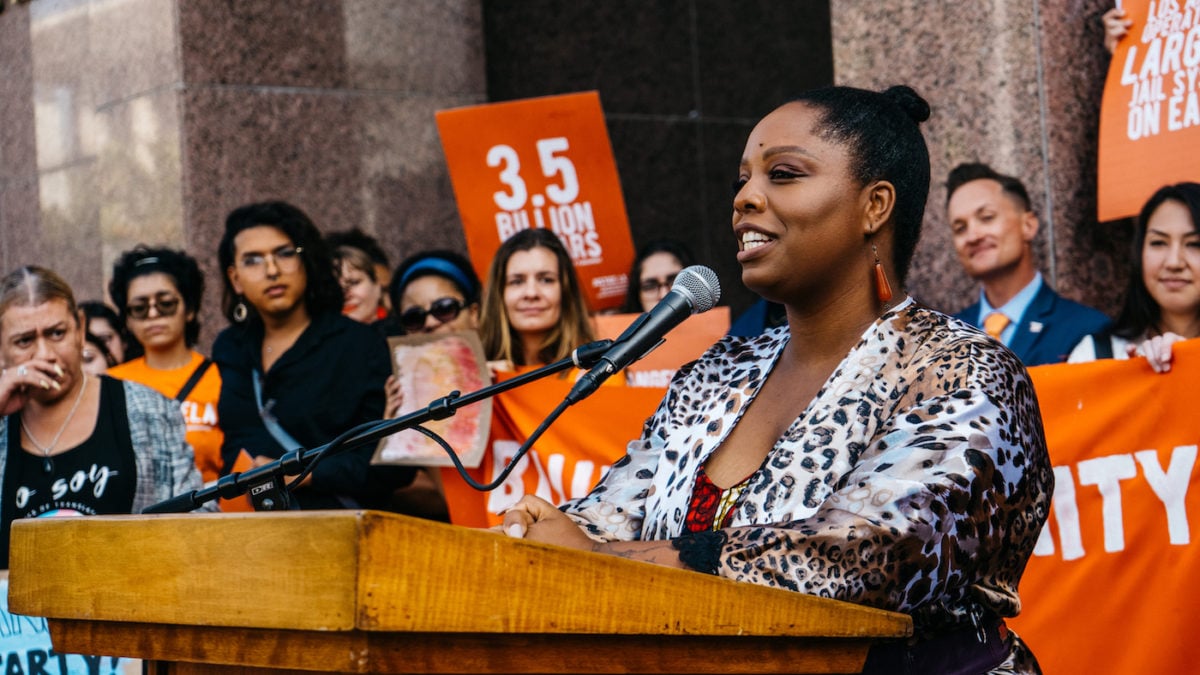(For June, which is designated LGBTQ Pride Month, Q Voice News features a series of interviews and first person essays under the theme What Pride Means To Me. Q Voice News launched the series last year. Check out 2019’s essays on What Pride Means to Me.)
Patrisse Cullors says her political art is about survival.
“If your community is under attack, whether that’s the queer community, the Black community, the trans community, or women, our response is survival,” says Cullors, who identifies as queer and co-founded Black Lives Matter in 2013.
“When we talk about race, when we talk about gender, or when we talk about politics, we’re talking about it because we’re talking about how we are going to survive a place that is oppressing us because of these things, because of who we are, because of our identities.”
Cullors’ newest performance art piece is “A Prayer for the Runner.” It’s described as a “public act of mourning,” centered on a prayer she co-wrote with Damon Turner, inspired by the “modern-day lynching” of Ahmaud Arbery.
Cullors will perform the piece live Saturday at noon during a virtual event. It will be followed by a discussion with Melina Abdullah, founder of Black Lives Matter’s Los Angeles chapter. The event is part of a series of events at the Fowler Museum at UCLA for LGBTQ Pride Month.

In this undated photo, Patrisse Cullors, at the podium, speaks during a rally supporting Measure R, which voters overwhelmingly approved in March 2020. The measure gives the Los Angeles County Civilian Oversight Commission the power to investigate, research, and create a Comprehensive Public Safety Reinvestment Plan to reduce jail population and provide alternatives to incarceration. Photo: Patrisse Cullors.
Cullors loves when political activism and art intersect.
“I feel like my work is part of the legacy of queer arts, but also the legacy of the black arts movement,” Cullors told Q Voice News last year. “I’m excited about that intersection.”
In an interview with Q Voice News, Cullors, 36, talks about what Pride means to her and the intersectionality of being Black and queer.
Here are some excerpts.
What Pride means
“Pride means so many things,” Cullors says. “I came out at 15 years old. It was a time when sodomy laws still existed in California, when gay marriage hadn’t been passed, where me and my girlfriend were being harassed on the street for being publicly out and queer.
“It felt really important for me as a black queer woman to remind people that I was unafraid and unapologetic,” she says.
“Pride is something deeply personal, but it’s also very political. My pride has everything to do with the community where I come from,” Cullors says.
“I’m from Los Angeles. I’m born and raised here. I’m born and raised in a suburb, outside of the inner city, in Van Nuys,” she says. “Pride also is my Southern roots. My family on one side is Creole from Louisiana. The other side is from Oklahoma. My pride is in being someone who identifies as pansexual and queer.
Accepting the “black weirdo”
“I have always known that I was different, you know, in quotes, than other people. I really accept the Black weirdo, as I often lovingly call myself. I am proud of it in how I talk about myself, and how I show up for myself.”
Her Pride evolves
“It is ever evolving. It is healing. It is a call and response for myself,” Cullors says.
“Some days I feel like, ‘Yes, I’m in the pocket of my Pride.’ Some days I’m like, ‘Ooh, it’s a little more difficult today.’
“The days it’s a little bit more difficult, I talk to my therapist. I talk to my community and my friends, and I let people love me.”
Black and queer
“When I came out, I was coming out to my peer group, and we were all mostly young, queer women of color,” Cullors says. “I didn’t know there was an issue around racism in the queer community until I started to go outside my friend circle and started to go to queer spaces.
“As I started going to queer spaces and events as an adult, I realized there was very little conversation about anti-Blackness,” she says. “Often, in Black Movement spaces, I always felt like we couldn’t talk about queerness and womaness. I really craved a space that we could talk about it all, and be our whole selves.
“Black Lives Matter really turned into that (seven) years ago, when we started it.”
Black Lives Matter
“The organization Black Lives Matter Global Network has three founders. Two of us are queer, and much of our base is black women and queer black women,” Cullors says. “Much of our organization, about 90% of it, is women. I would say almost 60% are queer.
“Homophobia wasn’t much of an issue,” Cullors says. “It was more about how the general population related to us. We’ve heard black folks outside our network say that Black Lives Matter has a gay agenda.
“Yes, homophobia has been clear,” Cullors says. “But there’s also been Black folks who have said, Thank God for a Black organization that isn’t solely steeped in with the church that is run by mostly Christian men.
“It’s been amazing to have Black queer women have different faiths and spiritualities be a part of this movement, too,” Cullors says. “It’s so refreshing.”
